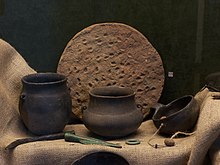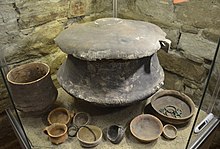Lusatian culture
|
||||||||
| expansion | ||||||||
|---|---|---|---|---|---|---|---|---|
|
||||||||
| Leitforms | ||||||||
|
The Lusatian culture is currently from around 1300 BC. BC ( Bronze Age ) to approx. 500 BC Dated BC ( Iron Age ). The Iron Age section is also treated separately as the Billendorfer culture . The most important subsequent culture is the East Germanic Przeworsk culture (3rd century before to 5th century after Christ).
The Lausitz culture is not to be confused with the Luboszyce culture (Lebus-Lausitz group).
Research history
The name "Lausitzischer Type", after the Lausitz , from which the first finds came, goes back to the German doctor Rudolf Virchow .
distribution
The Lusatian culture was spread from the Saale , Spree to the Danube , Vistula and the Slovak Ore Mountains (central Slovakia ). Adjacent were further groups of the Urnfield Culture in the west and those of the Nordic Bronze Age in the northwest .


Important sites
- Biskupin in Poland, reconstructed low castle
- Cemetery of Niederkaina in Saxony
- Cemetery of Liebersee in Saxony
- Kietrz burial ground in Poland
- Römerschanze near Potsdam , castle
- Cinder wall on the Löbauer Berg
- Burg (Spreewald) , "Schloßberg" Niederungsburg
- Łęgowo burial ground
- Otterböte in Åland
Funeral customs
One of the essential characteristics of the Lusatian culture are the large burial grounds, which were often occupied over many generations, i.e. over several hundred years. Including many found with more than 1,000 graves, such as the burial ground of Kietrz with previously discovered more than 4,000 burials or burial ground Łęgowo . In addition to tons of ceramics, there are also clay rattles . Typical are timbered grave borders with extensive ceramics inside and stone alterations outside, like in Groß Jauer in Brandenburg .
Settlement
Like most other Bronze Age cultures in Central Europe, post-house settlements were typical of the Lusatian culture. On the basis of reading finds and excavation results, a picture of hamlet-like settlements is shown, which are preferably located on southern slopes near rivers.
Few recognizable house floor plans show dimensions of up to 8 × 28 meters. Partitions separate different areas within the houses from each other. The walls of these buildings consisted of wickerwork plastered with clay, as demonstrated by finds of smelting clay with negative wood and wickerwork.
Fortified castles can be found both on mountain ridges and in swampy lowlands.
The hump ceramics of the north and the spiral ornamentation of the south merged into the Bronze Age humpback vessels of the Lusatian type, where the hump is often emphasized by concentric circles and is clearly reminiscent of breasts. Similar decorated vessels were also found in the Balkans and Anatolia (Troy VII).
Ethnic interpretation
Due to the lack of written evidence, we know nothing about the language spoken by the bearers of this culture. At the beginning of the 20th century, German researchers like Gustaf Kossinna claimed a Karpo - Dacian , later, based on Alfred Götze , a North Illyrian “ethnicity”, while the Czechs Pič and above all the Polish researcher Jozef Kostrzewski saw them as Ur Slavs . For a (pre) Germanic linguistic identity or ethnicity of the carriers of the Lusatian culture speaks that the area of distribution of this culture was settled by the (east) Germanic tribes of the Przeworsk culture at the turn of the times and there are no indications of major migration movements in this area in the second half of the 1st millennium BC.
literature
- Jan Fornfeist: The discovery of the bird shell from the burial ground of the Lusatian culture in Cottbus-Ströbitz. In: Excavations in the Lower Lusatian lignite area 2013/2014. Working reports on the preservation of monuments in Brandenburg 30. Cottbus 2016, ISBN 978-3-910011-79-3 , ISSN 1436-249X , pp. 65–70.
- Jan Fornfeist: The late Bronze Age part of a Bronze and Iron Age burial ground of the Lausitz culture of Cottbus-Ströbitz and the discovery of a bird's shell. In: Insights - Archaeological Contributions for the South of Brandenburg 2010/2011. Working reports on the preservation of soil monuments in Brandenburg 24. Koethen 2014, ISBN 978-3-910011-71-7 , ISSN 1436-249X , pp. 23–32.
- Jan Fornfeist: New bird bowl of the Lausitz culture. The most recent Bronze Age burial ground in Cottbus-Ströbitz. In: Archeology in Berlin and Brandenburg 2011, Köthen 2012, ISBN 978-3-8062-2778-9 , ISSN 0948-311X , pp. 55–57.
- Rosemarie Müller : Lusatian culture. In: Reallexikon der Germanischen Altertumskunde (RGA). 2nd Edition. Volume 18, Walter de Gruyter, Berlin / New York 2001, ISBN 3-11-016950-9 , pp. 144–157.
Monographs :
- Siegfried Gollub : Late Bronze Age graves in Central and Upper Silesia. A contribution to the structure of the Lusatian culture . Habelt, Bonn 1960.
- Dietgard Kühnholz: The beginnings of the Lausitz culture in Moravia and Slovakia (= university research on prehistoric archeology. Volume 227). Habelt, Bonn 2013, ISBN 978-3-7749-3530-3 .
- Johannes Schneider : Studies on Lusatian Culture . In: Research on Prehistory and Early History Volume 3. Barth, Leipzig 1958, ISSN 0532-2243 .
- Michaela Reichel: The archaeological finds of the Lausitz culture in the Germanic National Museum . (= Scientific supplements to the display of the Germanisches Nationalmuseum. 16). Germanisches Nationalmuseum, Nuremberg 2000, ISBN 3-926982-63-2 .
Web links
- Bronze Age cultures
- Lusatian culture on Archeology-Online
- Ceramics of the Lusatian culture from the teaching collection of the Department of Prehistoric and Protohistoric Archeology at the University of Münster , distribution map on page 6, accessed on December 17, 2013
Individual evidence
- ↑ Stefanie Beckert: Die Lausitzer Kultur ( Memento from February 18, 2010 in the Internet Archive ).
- ↑ Wolfram Euler , Konrad Badenheuer : Language and origin of the Germanic peoples. Demolition of Proto-Germanic before the first sound shift. Verlag Inspiration Un Limited, Hamburg et al. 2009, ISBN 978-3-9812110-1-6 , pp. 18-22, 28-30.
